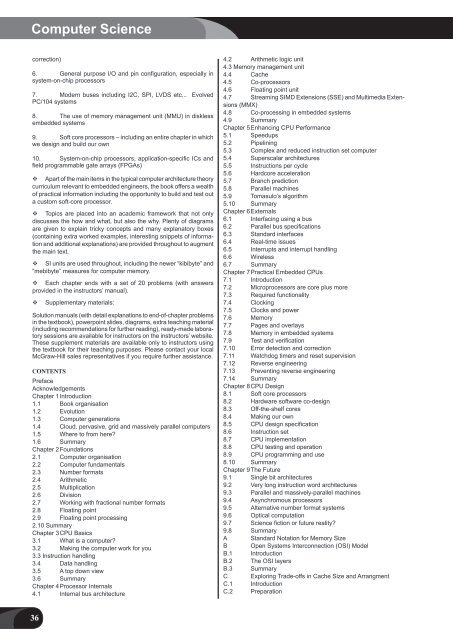Computer Science & Electrical Engineering 2012 - McGraw-Hill Books
Computer Science & Electrical Engineering 2012 - McGraw-Hill Books
Computer Science & Electrical Engineering 2012 - McGraw-Hill Books
Create successful ePaper yourself
Turn your PDF publications into a flip-book with our unique Google optimized e-Paper software.
<strong>Computer</strong> <strong>Science</strong><br />
correction)<br />
6. General purpose I/O and pin configuration, especially in<br />
system-on-chip processors<br />
7. Modern buses including I2C, SPI, LVDS etc... Evolved<br />
PC/104 systems<br />
8. The use of memory management unit (MMU) in diskless<br />
embedded systems<br />
9. Soft core processors – including an entire chapter in which<br />
we design and build our own<br />
10. System-on-chip processors, application-specific ICs and<br />
field programmable gate arrays (FPGAs)<br />
Apart of the main items in the typical computer architecture theory<br />
curriculum relevant to embedded engineers, the book offers a wealth<br />
of practical information including the opportunity to build and test out<br />
a custom soft-core processor.<br />
Topics are placed into an academic framework that not only<br />
discusses the how and what, but also the why. Plenty of diagrams<br />
are given to explain tricky concepts and many explanatory boxes<br />
(containing extra worked examples, interesting snippets of information<br />
and additional explanations) are provided throughout to augment<br />
the main text.<br />
SI units are used throughout, including the newer “kibibyte” and<br />
“mebibyte” measures for computer memory.<br />
Each chapter ends with a set of 20 problems (with answers<br />
provided in the instructors’ manual).<br />
Supplementary materials:<br />
Solution manuals (with detail explanations to end-of-chapter problems<br />
in the textbook), powerpoint slides, diagrams, extra teaching material<br />
(including recommendations for further reading), ready-made laboratory<br />
sessions are available for instructors on the instructors’ website.<br />
These supplement materials are available only to instructors using<br />
the textbook for their teaching purposes. Please contact your local<br />
<strong>McGraw</strong>-<strong>Hill</strong> sales representatives if you require further assistance.<br />
Contents<br />
Preface<br />
Acknowledgements<br />
Chapter 1Introduction<br />
1.1 Book organisation<br />
1.2 Evolution<br />
1.3 <strong>Computer</strong> generations<br />
1.4 Cloud, pervasive, grid and massively parallel computers<br />
1.5 Where to from here?<br />
1.6 Summary<br />
Chapter 2Foundations<br />
2.1 <strong>Computer</strong> organisation<br />
2.2 <strong>Computer</strong> fundamentals<br />
2.3 Number formats<br />
2.4 Arithmetic<br />
2.5 Multiplication<br />
2.6 Division<br />
2.7 Working with fractional number formats<br />
2.8 Floating point<br />
2.9 Floating point processing<br />
2.10 Summary<br />
Chapter 3CPU Basics<br />
3.1 What is a computer?<br />
3.2 Making the computer work for you<br />
3.3 Instruction handling<br />
3.4 Data handling<br />
3.5 A top down view<br />
3.6 Summary<br />
Chapter 4Processor Internals<br />
4.1 Internal bus architecture<br />
36<br />
36<br />
4.2 Arithmetic logic unit<br />
4.3 Memory management unit<br />
4.4 Cache<br />
4.5 Co-processors<br />
4.6 Floating point unit<br />
4.7 Streaming SIMD Extensions (SSE) and Multimedia Extensions<br />
(MMX)<br />
4.8 Co-processing in embedded systems<br />
4.9 Summary<br />
Chapter 5Enhancing CPU Performance<br />
5.1 Speedups<br />
5.2 Pipelining<br />
5.3 Complex and reduced instruction set computer<br />
5.4 Superscalar architectures<br />
5.5 Instructions per cycle<br />
5.6 Hardcore acceleration<br />
5.7 Branch prediction<br />
5.8 Parallel machines<br />
5.9 Tomasulo’s algorithm<br />
5.10 Summary<br />
Chapter 6Externals<br />
6.1 Interfacing using a bus<br />
6.2 Parallel bus specifications<br />
6.3 Standard interfaces<br />
6.4 Real-time issues<br />
6.5 Interrupts and interrupt handling<br />
6.6 Wireless<br />
6.7 Summary<br />
Chapter 7Practical Embedded CPUs<br />
7.1 Introduction<br />
7.2 Microprocessors are core plus more<br />
7.3 Required functionality<br />
7.4 Clocking<br />
7.5 Clocks and power<br />
7.6 Memory<br />
7.7 Pages and overlays<br />
7.8 Memory in embedded systems<br />
7.9 Test and verification<br />
7.10 Error detection and correction<br />
7.11 Watchdog timers and reset supervision<br />
7.12 Reverse engineering<br />
7.13 Preventing reverse engineering<br />
7.14 Summary<br />
Chapter 8CPU Design<br />
8.1 Soft core processors<br />
8.2 Hardware software co-design<br />
8.3 Off-the-shelf cores<br />
8.4 Making our own<br />
8.5 CPU design specification<br />
8.6 Instruction set<br />
8.7 CPU implementation<br />
8.8 CPU testing and operation<br />
8.9 CPU programming and use<br />
8.10 Summary<br />
Chapter 9The Future<br />
9.1 Single bit architectures<br />
9.2 Very long instruction word architectures<br />
9.3 Parallel and massively-parallel machines<br />
9.4 Asynchromous processors<br />
9.5 Alternative number format systems<br />
9.6 Optical computation<br />
9.7 <strong>Science</strong> fiction or future reality?<br />
9.8 Summary<br />
A Standard Notation for Memory Size<br />
B Open Systems Interconnection (OSI) Model<br />
B.1 Introduction<br />
B.2 The OSI layers<br />
B.3 Summary<br />
C Exploring Trade-offs in Cache Size and Arrangment<br />
C.1 Introduction<br />
C.2 Preparation

















